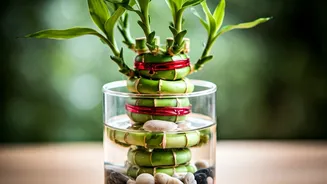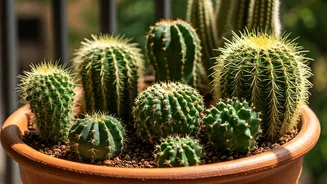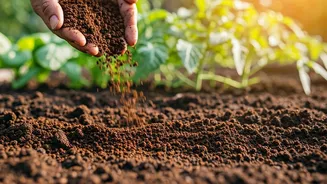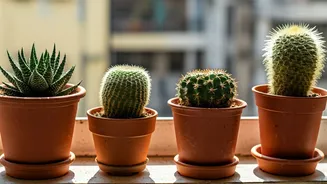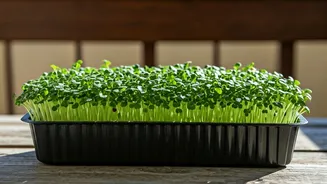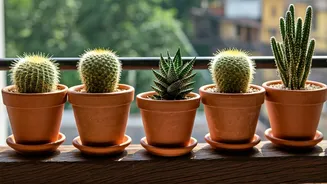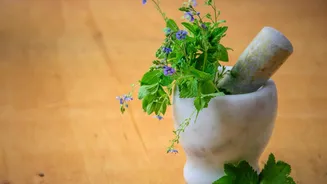Incorrect Lighting Conditions
Lucky bamboo thrives in bright, indirect light, much like the filtered sunlight found beneath the canopy of a tropical forest. One of the most common blunders
is exposing the plant to either too much or too little light. Direct sunlight can scorch the leaves, causing brown spots and overall damage, while too little light can lead to weak growth and pale leaves. The ideal location is near a window where the plant receives filtered light. You can achieve this by using a sheer curtain or placing the plant a few feet away from the window. Regularly observe your plant; if the leaves are yellowing or browning, adjust the lighting accordingly. Remember, the goal is to replicate its natural environment for robust growth, and finding the sweet spot with lighting is paramount for the vitality of your lucky bamboo.
Improper Watering Practices
Watering is crucial for lucky bamboo, but it's easy to get it wrong. Overwatering is a frequent mistake, leading to root rot, a condition that can quickly kill the plant. When the roots are constantly submerged in water, they lack oxygen, causing them to decay. The leaves will start to yellow, and the stem will become soft. To avoid this, use a well-draining container and let the top inch of the soil dry out before watering again. Underwatering is also harmful, causing the leaves to dry out and curl. If the plant gets too little water, it will struggle to absorb the nutrients it needs. It's best to water your plant when the top layer of soil feels dry to the touch. Another important factor is the water itself. Lucky bamboo is sensitive to chlorine and fluoride, so use filtered or distilled water whenever possible. This simple step can significantly improve your plant's health.
Choosing the Wrong Pot
The type of container you choose can significantly influence your lucky bamboo's health. Many people make the mistake of using pots without drainage holes. Without drainage, excess water accumulates, leading to root rot. If you're using a pot without holes, be extra careful with watering, or consider drilling some. The size of the pot also matters; a container that's too big can hold too much water, while a pot that's too small will restrict root growth. Select a pot that's slightly larger than the root ball, ensuring enough space for the roots to expand. The material of the pot is also a factor. Plastic pots retain moisture better than terracotta ones, so adjust your watering schedule accordingly. Ensure the pot provides adequate support and drainage for the plant to thrive. A well-chosen pot is key to creating a healthy environment for your lucky bamboo.
Ignoring the Water Quality
Water quality plays a vital role in the well-being of lucky bamboo. Tap water often contains chemicals like chlorine and fluoride that can harm the plant. Over time, these chemicals can build up in the soil and affect the plant's health, leading to yellowing leaves and stunted growth. To avoid these issues, always use filtered, distilled, or rainwater for watering your lucky bamboo. These types of water are free of harmful chemicals and provide a cleaner environment for the roots to absorb nutrients. If you opt for tap water, let it sit out for 24 hours to allow chlorine to evaporate before use. This simple step can significantly improve the health and appearance of your lucky bamboo. Also, make sure to flush the soil every few months with clean water to prevent any build-up of salts or chemicals that could be present in the water.
Overlooking Nutrient Needs
Lucky bamboo doesn't require excessive feeding, but it does benefit from occasional fertilization. Many people make the mistake of either not fertilizing at all or over-fertilizing their plants. Under-fertilization can result in slow growth and pale leaves, while over-fertilization can cause a build-up of salts in the soil, leading to root burn and other problems. If you decide to fertilize, use a balanced liquid fertilizer diluted to half strength. Apply the fertilizer every 2-4 months during the growing season (spring and summer). It's always best to err on the side of caution and use less fertilizer than more. Over time, you might notice salt buildup on the soil surface, which is a sign of excessive fertilization. If you notice this, flush the soil with water to remove the excess salts. A balanced approach to fertilization will promote healthy growth and vibrant colors in your lucky bamboo.
Ignoring Temperature Fluctuations
Lucky bamboo prefers a consistent temperature range between 65°F and 95°F (18°C and 35°C). Extreme temperatures can harm the plant. Placing your lucky bamboo in locations with significant temperature swings is a common mistake. Avoid areas near heating vents, air conditioners, or drafty windows, as these environments can cause the leaves to dry out or become scorched. Also, protect the plant from direct sunlight, as the heat can be intense and damaging. Temperature fluctuations can stress the plant and make it susceptible to various problems. Regular temperature checks are helpful to maintain a healthy growing environment. Be mindful of the surrounding conditions and keep the plant in a relatively stable environment. Keeping a steady temperature will help maintain the plant's health and enhance its appearance.
Not Cleaning the Plant
Dust and debris can accumulate on the leaves of your lucky bamboo, hindering its ability to photosynthesize. Many owners overlook the importance of regular cleaning. Gently wiping the leaves with a damp cloth can remove dust and dirt, allowing the plant to absorb more light and nutrients. This simple task can significantly improve the plant's appearance and health. Avoid using harsh cleaning agents or chemicals that could harm the leaves. A soft cloth and plain water are all you need. Regular cleaning also helps in spotting any potential pests or diseases early. By wiping the leaves frequently, you provide better access to sunlight, which is necessary for the plant's survival. Consider cleaning your lucky bamboo as part of your regular plant care routine to promote its health and longevity. This simple practice contributes to a cleaner, healthier plant.
Neglecting Proper Pruning
Pruning is crucial for maintaining the shape and health of your lucky bamboo, yet many owners neglect this vital step. Neglecting to prune can result in leggy, unruly growth. Pruning helps to control the size of the plant, encourage new growth, and remove any dead or yellowing leaves or stems. You can prune your lucky bamboo using clean, sharp scissors or pruning shears. Cut the stems at an angle to prevent water from accumulating and causing rot. Pruning also helps to maintain the plant's desired shape, such as spirals or towers. Regular pruning encourages a fuller, bushier appearance. The best time to prune is during the growing season (spring and summer), when the plant is actively growing. Avoid pruning too much at once, as this can shock the plant. Proper pruning is essential for maintaining a healthy and aesthetically pleasing lucky bamboo.
